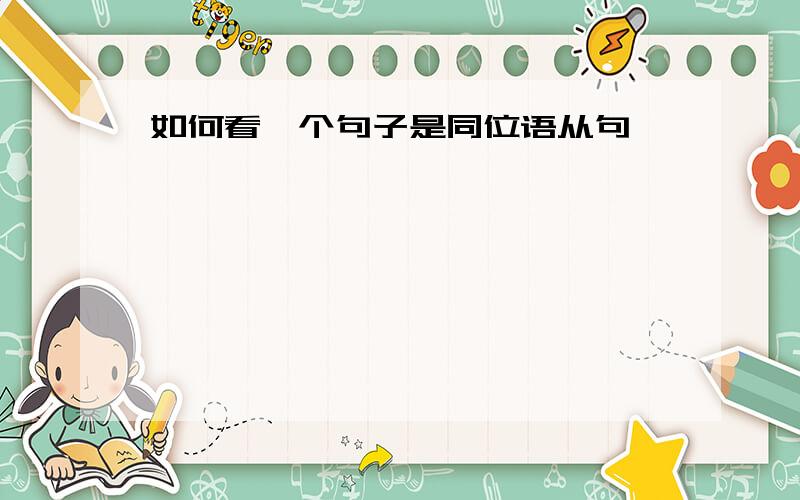如何看一个句子是同位语从句
来源:学生作业帮助网 编辑:作业帮 时间:2024/11/15 16:52:51

如何看一个句子是同位语从句
如何看一个句子是同位语从句
如何看一个句子是同位语从句
同位语部分是个句子,就是同位语从句,这种用法比较"固定"
一、在复合句中用作同位语的从句叫同位语从句.它一般跟在某些名词后面,用以说明该名词表示的具体内容.
I heard the news that our team had won.我听到了我们队获胜的消息.
同位语从句
二、可以跟同位语从句的名词通常有news,idea,fact,promise,question,doubt,thought,hope,message,suggestion,words(消息),possibility等(一般的“抽象”名词都可用).
I’ve come from Mr wang with a message that he won’t be able to see you this afternoon. 我从王先生那里来,他让我告诉你他今天下午不能来看你了.
三、英语中引导同位语从句的词通常有连词that,whether,连接代词what,who.连接副词how,when,where等.(注:if,which 不能引导同位语从句.)
He must answer the question whether he agrees to it or not.他必须回答他是否同意这样一个问题.
四、有时同位语从句可以不紧跟在说明的名词后面,而被别的词隔开.
The thought came to him that maybe the enemy had fled the city. 他突然想起可能敌人已经逃出城了.
同位语就是一个名词对另一个名词,代词进行限定修饰和说明的,这样的名词就是同位语。如
Yesterday I talked to my English teacher, Mr. James.(同位语Mr. James补充解释my English teacher,同位语与其同位成分之间可用逗点隔开。)
Mr. Smith, our new teacher, is very kind t...
全部展开
同位语就是一个名词对另一个名词,代词进行限定修饰和说明的,这样的名词就是同位语。如
Yesterday I talked to my English teacher, Mr. James.(同位语Mr. James补充解释my English teacher,同位语与其同位成分之间可用逗点隔开。)
Mr. Smith, our new teacher, is very kind to us.(Mr. Smith是主词our new teacher的同位语,指同一人。)
同位语从句一般跟在某些名词如answer(答案),hope(希望),fact(事实),belief (信仰),news(消息),idea(主意;观念),promise(承诺),information(信息),conclusion(结论),order(命令), suggestion(建议),problem(问题),thought (想法)等后面的;如:
He always works hard even if he knows the fact that he is not in good health. His failure was due to the fact that he had not practised for a long time. I had no idea that you were here. She told us her hope that she would become a pianist. He made a promise that he would never come late. 注意: that 既可引导同位语从句又可引导定语从句,其区别在于:同位语从句由连接词that引导,连接词that本身无意义,在同位语从句中不充当任何成分,不可省略,不可以用其他词替代;定语从句由关系代词that引导,关系代词that在从句中充当一定的成分,作宾语时可省略,由when, why, where引导的 同位语从句和定语从句的区别在于: 同位语从句由连接副词只起连接作用,没有指代作用; 定语从句由关系副词引导,关系副词具有指代先行词的作用,常用一个介词加关系代词替换,如:
I will never forget the day when we first met. (同位语从句, when为连接词) That is the special day (which/that) I will never forget. (定语从句,which/that为关系副词) This is the house where we lived fifteen years ago. (同位语从句, where为连接词) This is the house which we sold fifteen years ago. (定语从句,where为关系副词);
同位语从句用于解释说明前面的名词。如:
The fact that the earth is round is true. 地球是圆的的事实是真实的。(that从句用于解释说明the fact)
同位语基本上就是这样的,自己在看看其他的.多看看书..
收起